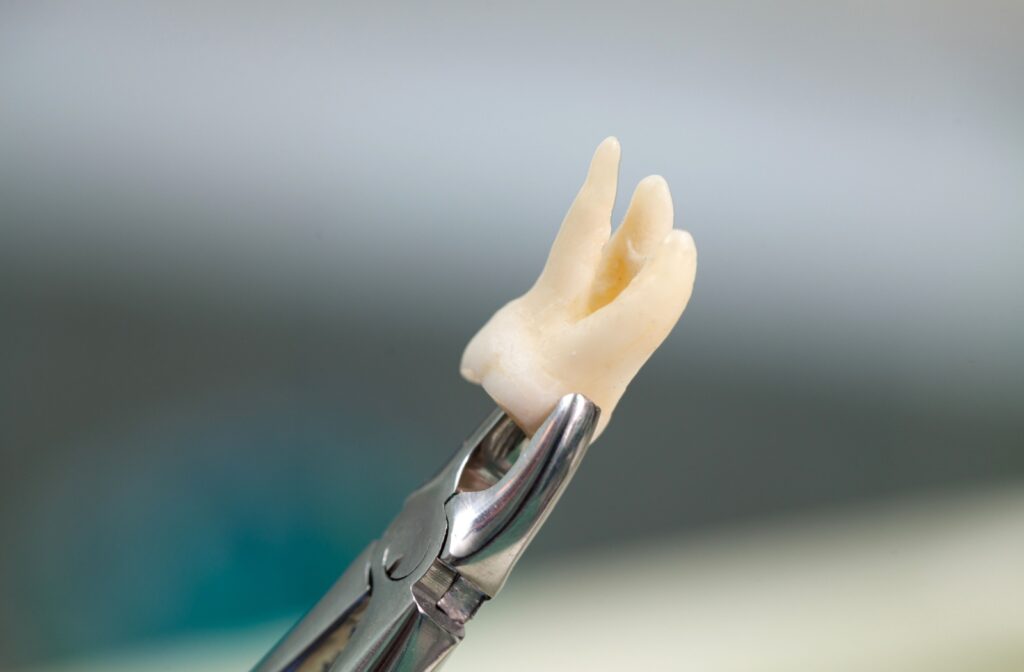Wisdom tooth extractions are a standard dental procedure, but how long do they take? The duration can range based on the complexity of the extraction, your unique anatomy, and whether the tooth is impacted.
For many, the thought of having wisdom teeth removed can seem daunting, but understanding the process—and what to expect—can help make it less intimidating. Your dentist can give you further information on the length of your procedure after having examined your teeth.
Why Do Dentists Remove Wisdom Teeth?
Wisdom teeth, also known as third molars, appear during early adulthood, typically between the ages of 17 and 25. Unfortunately, for many people, these late-arriving molars struggle to find room in the mouth.
When there isn’t enough space, wisdom teeth can become impacted (trapped beneath the gums), grow misaligned, or crowd other teeth. Left untreated, this can lead to discomfort, inflammation, infection, and even tooth decay.
Your dentist may recommend removing your wisdom teeth to:
- Relieve discomfort caused by overcrowding
- Prevent infections or cysts that could harm your gums or jawbone
- Make orthodontic treatments, like braces, more effective by eliminating overcrowding
- Avoid damage to surrounding teeth caused by pressure from impacted wisdom teeth
If you’re unsure whether you need your wisdom teeth removed, consult a dental professional, such as Marks Dentistry, who can evaluate your unique situation.
How Long Does it Take to Remove Wisdom Teeth?
The time it takes to extract wisdom teeth varies due to several factors, including:
- Tooth position: Teeth that are fully erupted above the gumline (simple extraction) usually take less time compared to those that are impacted (surgical extraction).
- Anatomy: Jaw shape, tooth root configuration, and surrounding bone density can influence the duration of the procedure.
- Number of teeth: Removing 1 wisdom tooth typically takes less time than extracting multiple teeth.
Simple Extractions
The procedure is straightforward for wisdom teeth visible above the gumline and is generally completed in less time than if surgery is required. Your dentist will likely administer local anesthesia to numb the area, loosen the tooth from the socket, and carefully remove it.
Surgical Extractions
A surgical extraction is usually done for impacted teeth or teeth growing at an angle. This involves making an incision in the gum and, in some cases, removing a portion of the bone for access. It will generally take longer than a simple extraction.

What Can You Expect After a Wisdom Tooth Extraction?
Recovering from wisdom tooth extraction can take one to two weeks, depending on the complexity of the procedure and your overall health.
Common Post-Procedure Symptoms
- Mild swelling or bruising around the jaw
- Bleeding from the extraction site for the first 24 hours
- Discomfort as the numbness wears off
- Difficulty opening your mouth fully
Post-Procedure Care
Your dentist will provide aftercare instructions to help ease your recovery. Some common recommendations include:
- Rest and recovery: This may include taking 1–2 days off work or school to allow your body to heal.
- Managing discomfort: Use over-the-counter pain relievers or prescription medication as directed.
- Diet adjustments: Stick to soft foods like soups, yogurt, or mashed potatoes. Try to avoid crunchy or chewy foods that may irritate the extraction site.
- Ice packs for swelling: Apply ice packs to your face intermittently during the first 24 hours to reduce swelling.
- Avoid smoking and straws: These actions can dislodge the blood clot and delay healing.
By following these guidelines, you can help promote faster healing and reduce your risk of complications like dry socket.
Tips for Speeding Up Recovery
- Prop your head up with pillows while resting to minimize swelling.
- Rinse gently with a warm saltwater solution after 24 hours to keep the area clean.
- Avoid touching the surgical site with your tongue or fingers.
- Brush carefully, avoiding the area around the extraction.
Every recovery is unique, so listen to your body and allow yourself ample time to heal.
When Should You See a Dentist for Tooth Discomfort?
While some occasional discomfort may not be a cause for concern, ongoing or severe symptoms warrant professional attention. Here are signs you should see your dentist:
- Throbbing discomfort in the back of your mouth
- Gum swelling, redness, or bleeding
- Difficulty fully opening your mouth
- A foul taste or odour
- High fever or chills
These could indicate impacted wisdom teeth, infection, or other oral health issues. Don’t wait—visiting a dentist early can help prevent complications and lead to better oral health.
Prevent Dental Issues with Regular Checkups
Regular visits to your dentist play a crucial role in maintaining good oral health. Wisdom tooth extractions are common procedures designed to prevent issues like overcrowding, infection, or decay. The procedure time depends on factors like the tooth’s position and your unique anatomy, but recovery is manageable with proper care.Experiencing tooth discomfort or worried about wisdom teeth? Schedule an appointment with Marks Dentistry today and take the first step toward better oral health.




